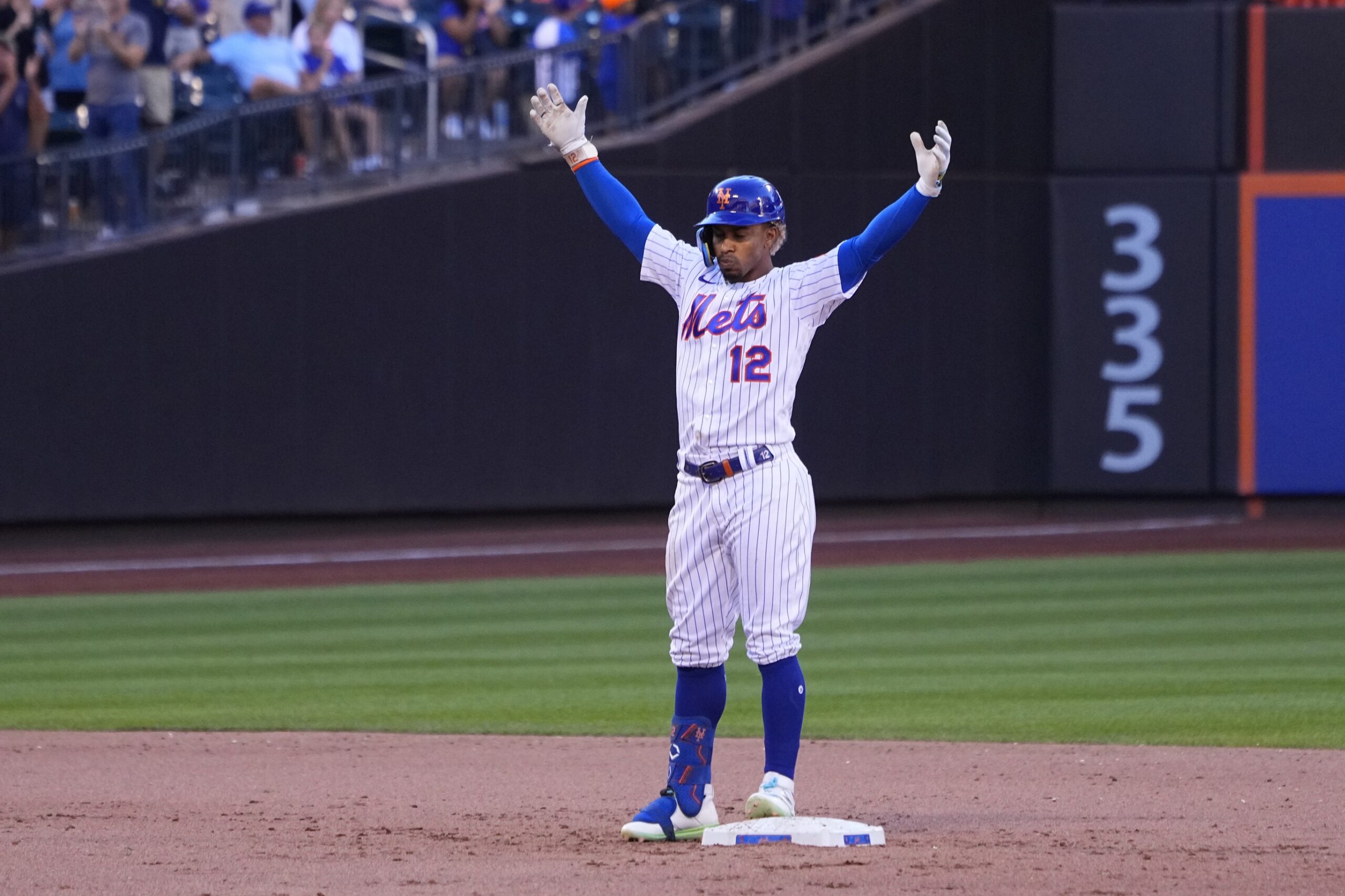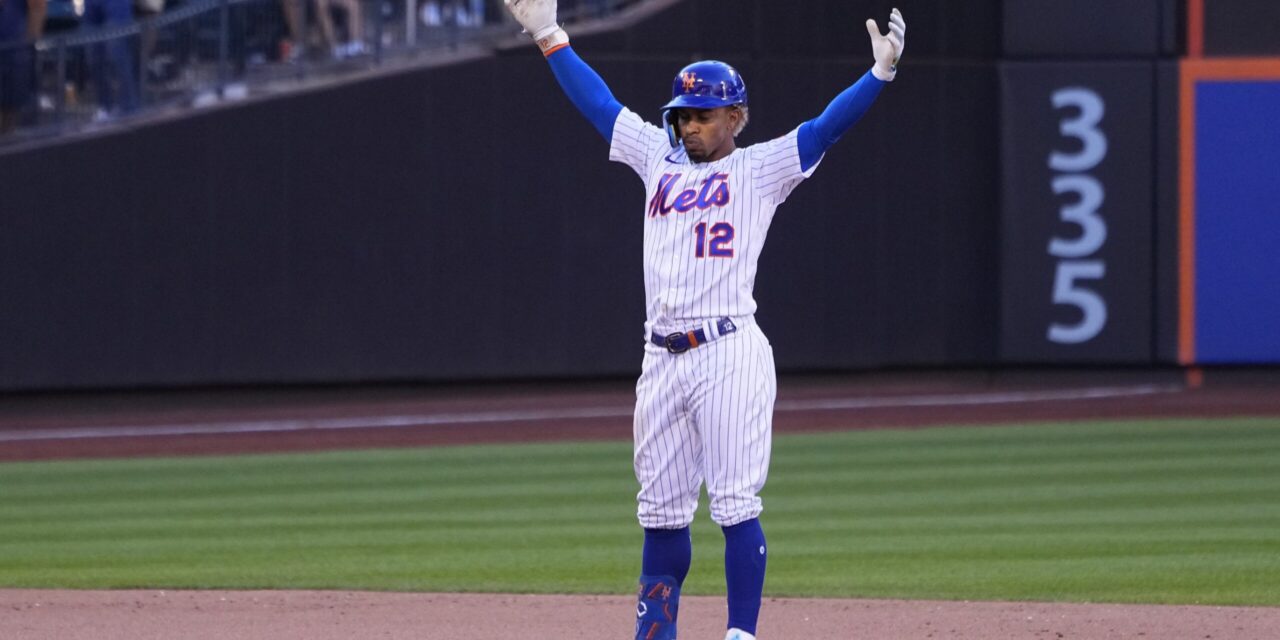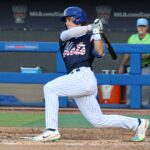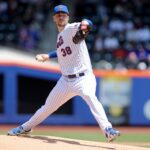
Francisco Lindor. Mandatory Credit: Gregory Fisher-USA TODAY Sports
All is forgiven for Francisco Lindor following a terrific bounce-back season in his second year with the New York Mets. Thumbs down and boos gave way to cheers as Mr. Smiles lived up to the expectations of an all-around player and team leader. On a team that ranked fifth in the majors in runs scored, Lindor was the second-biggest driver of those runs, as expected when he signed his 10-year, $341 million extension.
Following Lindor’s 2021 season, the trade in which the Mets acquired him from Cleveland didn’t appear too great. Sure, Lindor played much better in the second half of the season and his underlying metrics indicated that he got somewhat unlucky. Still, a 100 OPS+ is not what the Mets had signed up for.
Let’s reexamine that trade again, two years later. How are both sides looking? Who “won” the trade?
The Prize: Lindor
Obviously, the impetus for this trade was Lindor. The Guardians knew they could not afford to retain him in free agency and therefore unloaded him for the best deal they could get.
In six seasons with Cleveland, Lindor slashed .285/.346/.488/.834, averaging 29 homers and 85 RBI per 162 games (he played 99 games in 2015 and 60 in the pandemic-shortened 2020 season, so he had the equivalent of five years of service time). His OPS+ was 118, and he compiled 28.1 bWAR.
Lindor’s first season with the Mets did not go as planned. He hit just .230/.322/.412/.734 with a dead-average OPS+ of 100. He totaled just 3.1 bWAR, the lowest total of his career (excluding the pandemic year).
Furthermore, because Lindor’s OPS was just .698 in the first half of the season while the Mets were still competitive, there was a perception that he could not handle the pressure of New York. In this area, Lindor did himself no favors when he and Javier Baez made the thumbs-down signal to each other in a game, signaling their defiance towards the fans’ displeasure.
Lindor also had stark splits between the Mets’ wins and losses in 2021. In 62 wins, he hit .288/.397/.550/.947, but in 63 losses, he hit .174/.273/.278/.521. His OPS+ was 124 in wins and 73 in losses. When the Mets were ahead in games, he hit .271/.357/.556/.914; when they were behind, he hit .195/.281/.289/.570. This also furthered the idea that Lindor could not hit in big spots to help the team get over the hump.
Ironically, Lindor hit significantly better at home than on the road in 2021, which means the home fans got to see the better version of him, at least. At home, he hit .244/.335/.453/.788, certainly not an ideal batting average but actually similar to his overall 2022 output in terms of OPS. On the road, though, those numbers went down to .216/.310/.370/.680. That puts into question the narrative that the pressure of New York was too much for him.
In 2022, though, Lindor returned to his old excellent form. His overall slash line of .270/.339/.449/.788 and 125 OPS+ understate his value to the Mets. He posted 5.4 bWAR and 6.8 fWAR, which do a better job of describing how much the Mets needed him, as those numbers led the team. He also put up 26 homers and 107 RBIs, bringing the power element to a team that needed it.
As described in a previous article, many of Lindor’s underlying metrics were actually worse in 2022 than 2021. However, they were also more in keeping with his career norms: not hitting the ball quite as hard or as high, but making good contact in the zone and outperforming some of his expected metrics.
It also cannot be overstated how much value Lindor brings the Mets as a switch hitter. They feel comfortable slotting him in at the top of the lineup regardless of the handedness of the pitcher since he can hit both ways. In 2022, Lindor was remarkably consistent from both sides of the plate, hitting .269/.343/.446/.789 from the left side and .271/.327/.457/.784 from the right. His ability to hit lefties was a huge boon for a team that struggled to find consistency vs. southpaws.
After one difficult season and one strong one, there is no way to know for certain where Lindor will head in 2023. However, he had already started to come on in the second half of 2021, which means he has posted a year and a half of Lindor-like numbers. The ZiPS projections forecast 6.1 fWAR for him in 2023.
So far, this part of the deal seems to be working out for the Mets.
Carlos Carrasco
The Mets were thrilled to receive Carlos Carrasco as part of the Lindor package. Cookie was coming off a bounce-back Covid year in which he posted a 2.91 ERA (3.79 xERA), 3.59 FIP, and 1.5 WAR in 68 innings across 12 starts. From 2014-18, Carrasco was a rock-solid starter, posting ERAs no higher than 3.63 and FIPs as low as 2.44. He had a rocky 2019 before his leukemia diagnosis, but rebounded in 2020.
However, Carrasco’s first year in orange and blue never really got off the ground. He missed the first three-and-a-half months of the season with various injuries. When he returned, he pitched just 53.2 innings across 12 starts, posting a 6.04 ERA, 67 ERA+, and a 5.22 FIP. He was particularly terrible against right-handed batters, allowing a .296/.347/.600/.947 line (155 OPS+) in his supposed platoon advantage.
In Carrasco’s second season with the Mets, he was penciled in as the fourth or fifth starter during spring training. He often functioned as a third starter during the season, though, due to injuries up and down the Mets rotation throughout the year.
On the surface, 2022 was another bounce-back season for Carrasco. He pitched 152 innings across 29 starts, posting a 3.97 ERA and 3.53 FIP. However, his 1.32 WHIP meant that he was working in and out of trouble every game. In addition, his 97 ERA+ indicates that he was slightly below average in ERA when adjusting for the ballparks he pitched in. He put up 2.4 fWAR, which is okay for a fifth starter.
Carrasco’s biggest asset as a pitcher was getting batters to chase pitches out of the zone, placing in the 94th percentile. He was also above average in whiff rate (65th percentile) and the spin on his curve (75th). However, his poor hard-hit rate (32nd) was one of the drivers of his high WHIP, which put pressure on his defense and led to many high-leverage pitching situations.
Overall, Carrasco’s part in the Lindor deal has been uneven. He battled injuries and poor performance in 2021, but the sum total of his performance in 2022 was close to what the Mets could have realistically expected from him at his age and given his career trajectory.
There has been some trade speculation about Carrasco this offseason. However, there does not appear to be anything imminent in the works. As of now, Carrasco will likely play out his one-year team option for $14 million in his age-36 season and then become a free agent.
The Mets would be thrilled if Carrasco can give them a repeat performance from last year. He once again enters spring training as the fifth starter. Given his age and injury history, along with the ages of the Mets’ other starters, the team will likely end up relying significantly on their starting pitching depth, including David Peterson, Tylor Megill, Joey Lucchesi, and Elieser Hernández.
Carrasco’s ZiPS projection forecasts 140 innings pitched for Carrasco with a 4.35 ERA, 4.24 FIP, and 1.1 fWAR. The Mets would be happy with those innings numbers but hope for some better production. However, the amount of hard contact Carrasco allowed in 2022 would tend to indicate that his .337 BABIP was not fluky and will correlate with worse results as he continues to age.
Andrés Giménez
Many Mets fans liked Andrés Giménez, who displayed a plus glove and some intriguing hitting skills in his time with the Mets. However, a price had to be paid for Lindor, and New York now had two shortstops who were rendered redundant in Gimenez and Amed Rosario.
Giménez’s first season in Cleveland went far less swimmingly than even Lindor’s in New York. He hit .218/.282/.351/.633 in 210 plate appearances for the Guardians, posting a 74 wRC+ and 0.8 fWAR while striking out 25.7% of the time. Defensively, he played a fine shortstop, posting 5 OAA and 4 DRS in 322 innings. He was not as good at second base, putting up -1 OAA and -2 DRS in 196 innings.
It appeared that Giménez was never going to make it as a hitter enough to develop as a starting-caliber middle infielder. However, he was still just in his age-23 season and had time to grow as a hitter.
2022 was a totally different story for the diminutive Giménez. In 146 games, a full starter’s slate, he made the All-Star team and looked like the player the Mets had seen glimpses of at times when he was a rookie. Giménez hit .297/.371/.466/.837 with 17 homers, 69 RBI, and 140 wRC+. His 6.1 fWAR was among the top for middle infielders.
Interestingly, Giménez’s Statcast numbers read somewhat similarly to Jeff McNeil‘s, as he recorded a .353 BABIP, which was identical to McNeil’s. He was also below average in both hard-hit rate, barrel rate, and average exit velocity, although not quite as low as McNeil. The main difference is their batting eye and expected batting average: McNeil was in the 99th percentile in strikeout rate and the 91st in whiff rate, while Giménez was in the 56th and 39th in those areas, respectively.
Still, Giménez seems like a typical Mets prospect: a seeing-eye hitter who can hit it where the fielders aren’t. If he can keep that up, the Guardians will have gotten back a player who can make up for a lot of what they lost in Lindor. Indeed, Giménez’s 17 homers and .837 OPS show that he’s not even that far behind Lindor in the power department (if at all). Not bad at all for what was supposed to be a one-sided trade.
Of course, Giménez needs to show that he can sustain his success rather than be a one-year wonder. His ZiPS projection for 2023 is .266/.336/.416/.752 and 4.9 fWAR, which is a significant drop-off from his 2022 height (although still solid). However, since ZiPS takes into account the previous three seasons in the projection, Giménez can outperform it significantly if 2022 was a true breakout.
Amed Rosario
The other major leaguer involved in the deal was Amed Rosario, another shortstop who had shown flashes of potential with the Mets. However, after a strong finish to 2019, Rosario reverted back to his high-strikeout, low-contact prior ways in 2020.
Rosario has been just about an average player for Cleveland in both of his seasons with them. His slash lines of .282/.321/.409/.730 and .283/.312/.403/.715 are about what you’d expect from a player with his hitting profile. He posted an identical WAR of 2.4 and wRC+ of 99 and 103, respectively. That is pretty much textbook average.
Statcast metrics for Rosario are all over the map. He doesn’t hit the ball that hard (41st percentile in hard-hit rate and 39th in average exit velocity) or barrel many balls (18th) and his chase rate is terrible (4th), but his whiff rate is above average (74th) and he did not strike out a lot in 2022 (79th). His batting eye has seemingly improved since his days with the Mets, but the results aren’t all that different.
Rosario placed in the second percentile in OAA in 2022, which makes him a very poor defensive shortstop.
Overall, Rosario is a competent major-league starter who seems unlikely to develop into anything more than that. His defense is a liability that lowers his value, but his hitting is good enough to keep him in the lineup. He was a decent complementary piece for Giménez in the deal.
OF Isaiah Greene and RHP Josh Wolf
These two were minor leaguers of little consequence for the Mets. Both were in A-ball in 2022. Isaiah Greene hit .226/.393/.340/.733 in 114 minor league games last season. Josh Wolf had an ERA over 6.00 between rookie ball and Class-A. They are 21 and 20 years old, respectively, so there may be some time for them to develop, but neither appeared on the Guardians’ MLB.com top 30 prospects list in 2022.
Who Won the Trade?
After two years, the Mets still received the biggest star of the deal. Lindor’s combination of power, defense, clutch hitting, speed, and leadership cannot be underestimated. He has a solid history of above-average play. Carrasco also provided the Mets with value.
However, this trade has not turned out quite as one-sided as it appeared at the time, at least as of now. Giménez had a year that rivaled Lindor’s in many areas. Rosario is almost as serviceable a hitter as Carrasco is a pitcher, and he’s 27 years old to Cookie’s near-36.
I believe that each side is likely satisfied with what they have. Should the Guardians have gotten a higher-ceiling prospect than Rosario in return for one of the best shortstops in the league? Likely, but they did not have leverage due to their noted inability to pay Lindor and the influx of top shortstops hitting the free-agent market the following offseason. Considering that trade position, if Giménez can sustain his 2022 success, it will truly be a win for the Guardians, as well.
The one regret that the Mets might end up having is giving up Giménez instead of Ronny Mauricio. At the time, Mauricio was considered the Mets’ second-best prospect, as he was No. 67 on MLB.com’s top 100 list in 2021. It was quite the coup not to have to give him up for Lindor. However, Mauricio has now fallen out of the top 100 (although he is still on Keith Law’s list at No. 87), and there are questions about his long-term prospects in the majors.
Hindsight is always 20-20, but imagine this Mets team with Lindor at shortstop, Gimenez at second, and McNeil in left field (or wherever else the Mets chose to place him on any given day). Still, you’ll hear few complaints from Mets fans who have their second- or third-best hitter locked down for a decade.
We’ll continue to revisit this trade as the years go by. For now, consider Steve Cohen’s first big splash with the Mets a good one.
















